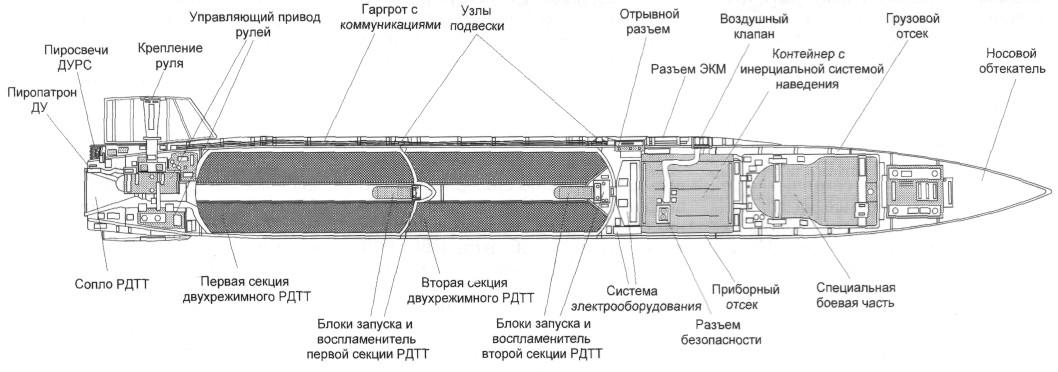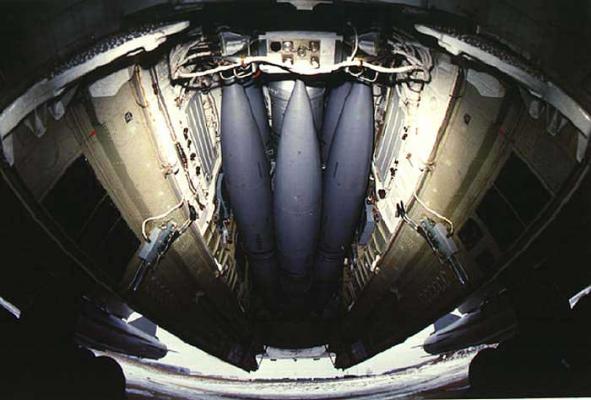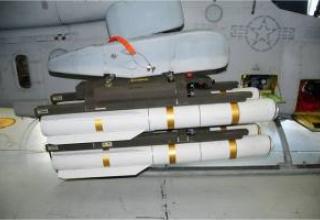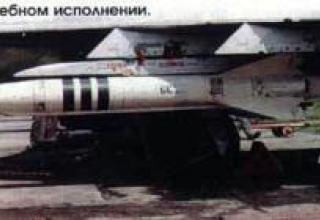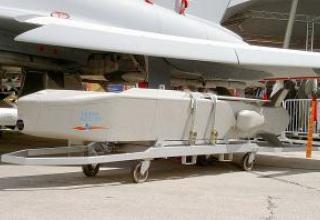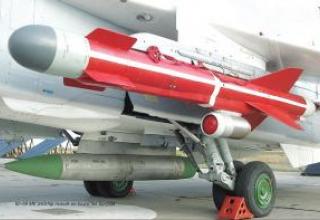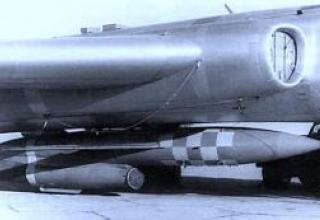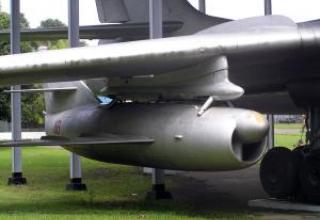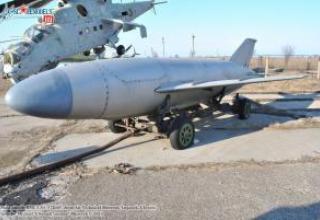Aeroballistic missile X-15 ("item 115") is designed to provide a breakthrough of the enemy's air defense system by long-range aircraft, destruction of long-range air defense systems such as "Patriot", "Hawk" and stationary ground targets.
The missile was developed at the Rainbow Design Bureau under the supervision of Chief Designer I.S.Seleznev. The X-15 prototypes were produced by NPO "Raduga" in 1978. The X-15 missile is considered the Soviet response to the American AGM-69A "SRAM" missile.
Tests of the X-15 from a Tu-22M aircraft were conducted in the late 70's. The basic version of X-15 with nuclear warhead was adopted for service in 1980. Serial production was organized at Dubna Engineering Plant - DMZ (until 1982 DMZ was part of PA "Rainbow"). Aircraft carrier rocket X-15 became Tu-95MS, Tu-22M3 and Tu-160. Improved version of the X-15P missile is equipped with a passive radar head self-homing (PRGSN) and a shrapnel-phase combat unit and is designed to destroy the enemy's radar. KH-15P missile was adopted for service with the Soviet Air Force in 1988 and entered the 184th Guards TBAP and 1230th (now - 121st Guards) TBAP on Tu-160 aircraft, as well as three regiments of the 37th Military Military Command on Tu-22M3 aircraft.
As not having strategic capabilities, the X-15 system was not subject to international restrictive treaties, and its existence was not made public even in the era of glasnost until March 1992, when these missiles were presented at a government show of new equipment at the airport Machulischy. It is curious that at the first public display data X-15 was called significantly underestimated, and its range was considered not to exceed 150 km - half the actual.
With the improvement of air defense, X-15 missiles did not provide a safe range impact anymore. The missiles themselves were still vulnerable, but this did not apply to the aircraft carrier. Full "unloading" of a set of missiles on board required a fair amount of time and in dangerous proximity to the target seemed risky. The DRLO (AWACS) aircraft were detected by bombers even at low altitudes from a distance of up to 700 km, bringing into battle interceptors from the borderline of 550-600 km. As they approached further to target, the missiles were placed near the effective firing area of the SAM system. At the same time, the launch of each X-15 required the execution of an 11-second cycle, and a simple calculation showed that in order to "shoot off" all 10 missiles, it was necessary to stay on the combat course "without moving" and maintaining the direction to the target near the air defense zone (or even within it) for a fairly long time. "Unload" full ammunition Tu-160, which was supposed to carry 24 of these missiles, it seemed and is not real at all in this situation. At the same time in the normal operation of the X-15 has earned a reputation as a "trouble-free weapon", confidently holding the trajectory and hitting the target.
The technical staff of the X-15 had their own claims: the suspension of the drum and docking communications of the MKU in gruzootseke was difficult. To install under-wing ACUs and connect the electrical fittings needed to climb inside the wing, where you could barely turn and work to the touch (especially in winter, when you get into a tight bay could only take off warm clothes and work in the freezing cold in one shirt). Over time, another problem was revealed - the limited shelf life of the rocket fuel (the Americans had to write off their SRAM, which began to decompose the fuel mixture - "soaping" and cracking in order to produce ten-year engine life). In view of the approaching expiration of the storage period, by early 2000, it was decided to rationalize the existing stocks of X-15 with their use in combat training by intensive firing.
To the expected equipment X-15 heavy bombers Tu-160 did not come to the case. In the armament complex, the aircraft could carry up to 24 missiles on four ICU in two gruzootseke, but priority was given to long-range cruise missiles X-55, more consistent with the strategic purpose of the machine. Nevertheless, the program was adopted to equip the X-15 aircraft and appointed terms of implementation of the complex on the Tu-160, which were going to hold in 1991-94. In the leadership (and the only one in the Soviet Air Force) 184 th gv. Poltava-Berlinskogo Order of the Red Banner TBAP in Priluki received only 3 models of X-15, designed for training and linking systems. The factory brigade for the revision arrived in autumn 1991, too late for the implementation of plans - the beginning of the collapse of the Soviet Union forced to postpone all work, and the subsequent severance of ties and the economic crisis finally prevented their implementation.
In 1993, an anti-ship version of the X-15 was presented at an exhibition in Abu Dhabi, which received the designation X-15C (X-15A). The rocket was designed to defeat ships of various classes, from boats to destroyers and cruisers and carried a penetrating blast furnace weighing 150 kg. At the initial stage, the X-15S was controlled by the INS with the entry on the border of the capture and further switching to the active CNS. The attack of a large target could be carried out from the distance of 150 km, of a boat type target - from 50-60 km. This missile is offered for export under the index X-15SE, as a carrier can be used Tu-22M3, Su-24MK, Tu-142ME, Su-27K, Su-27IB and other aircraft.
In the west, the missile was designated AS-16 "Kickback".
Composition:
The X-15 missile has a wingless circuit with cantilever all-twist plumage (see projections).
The casing is divided into compartments: instrument room, cargo room with BC, engine room and control drives. Due to the high flight speed (at M=5 - more than 1000 degrees), the rocket body is subjected to significant aerodynamic loads and heating, to ensure the required reserve of strength it is made of titanium OT4-1 and VT-5, has external heat protection and internal thermal insulation. The surface of the missile's airframe is covered with a special metallized coating to improve its reflectivity under radar irradiation. The peculiarity of the X-15 design was the practical absence of hatches - mounting and operational, through the gaps of which the nodes could be exposed to thermal flows. Even at installation of steering wheels access to knots of their fastening was carried out, from end-faces of steering surfaces.
A composite nose fairing with a complex ogival shape was developed in several design options. In the three-layer structure, each layer was formed from its own type of fabric with impregnation of binder resin and heat treatment, then the next one was applied, etc. This process was complex and time consuming. The more successful and technologically advanced was the two-layer version with glass facing. The fairing was manufactured in rigid molds by means of pressure impregnation with simultaneous pressing of metal frames on the glue. From the outside, it was covered with a layer of heat protection.
As heat protection of the metal structure the external coating with special material was used, which also played a radio absorbing role. It was necessary to apply a layer of heat protection to the surface of the body, gargots and steering wheels, observing the specified thickness, with subsequent heat treatment for baking. The liquid layer of heat protection material was applied to metal compartments directly in rigid molds by means of pressure impregnation, on steering wheels by means of vacuum "suction" and forming in an autoclave.
During heat treatment, a number of units were already partially assembled, and the composite parts included in them were warped. For compensation of deformations metal details made not according to constructive, but according to technological drawings began to be supplied, the sizes in which were set with preemptive on size of temperature deformations, and products were warmed up in rigid compression moulds.
The missile is controlled by the deflection of all-terrain steering wheels equipped with electromechanical drives. The two lower rudders, nicknamed "flippers", controlled the missile along the pitch channel in case of combined deflection, and in case of differential - along the pitch. They also parry the tilting moment when the upper rudder is deflected to correct the course.
The novelty was the original solid fuel engine, first used in the USSR on a rocket of this class. Dual-mode RDTT-160 has a two-chamber design, connecting two stages in one body - the starting and marching, separated by a partition and switched on in series by their ignition systems. The engine uses a mixed fuel that combines high-calorie fuel and an oxidizer that releases oxygen needed for combustion. The fuel is cast directly into the engine housing with a profiled inner star-shaped channel that increases the area of gas formation and, consequently, the working pressure in the combustion chamber and traction. For long-term storage, the inner cavity of the engine charge is sealed with a special shell inflated with inert gas.
The X-15 missile is equipped with a small-size special BC capacity of 350ct with a thermonuclear charge (training missiles carry a simulator of special BC and a blast charge of small power, allowing you to control the hit).
The rudders are made of titanium OT-4 with external heat protection coating, the rudder socks are made of heat-resistant tungsten-molybdenum alloy VM-1. Rims of compartments and gargots - made of heat-resistant steel VZh-100. The X-15P and X-15S missiles have a radio-transparent ogival nose fairing with thermal insulation (TKCH-6), lined with ATOM-2 fabric.
When mastering the production of X-15 missile at the DMZ were introduced new technological processes:
- Manufacturing of fairings of a two-layer construction in rigid moulds by a method of impregnation under pressure with simultaneous pressing on glue VK-20 of two metal frames.
- application of MKT heat-shielding material directly on the metal compartments of the rocket airframe in rigid molds by the pressure impregnation method
- application of heat-shielding material to the steering wheels by autoclave vacuum forming.
For the manufacture of large-size parts of the X-15 rocket, requiring stringent heat treatment conditions, at the DMZ was developed and built a large, high-temperature furnace with a temperature difference of ± 50 °. This allowed qualitatively without residual deformation to perform heat treatment of parts, including in rigid devices (thermal calibration). The shells made of BT-20 alloy were processed by this method.
Modifications:
- The X-15 is basic,
- X-15P - anti-radar (see diagram). It is designed to break through the enemy's air defense zone by long-range aircraft. It is equipped with passive radar CNS and shrapnel BC.
- X-15C (X-15A) - anti-ship (see the scheme), is equipped with interference-resistant active radar CNS, operating in the mm-range. The X-15S rocket is fired according to the "shot and forgotten" principle, but relatively precise coordinates of the target, its course and speed must be entered before the control system can be launched from the carrier. The X-15S missile is equipped with a penetrating combat unit weighing 150 kg. It is offered for export under the designation X-15SE.
The X-15 missile is launched from MKU-6-1 rotary units or from single beam holders. Carriers of X-15C can be Tu-160, Tu-95MS, Tu-22M3, Su-27K and Su-27IB aircraft. Tu-160 carries 24 X-15 missiles on 4 revolvers MKU-6-1 in 2 compartments. Tu-22M3 is equipped with one MKU-6-1 in the compartment and four external ACU-1, mounted instead of beam holders of X-22 missiles. Management of the release and cleaning of the ACU-1 is carried out from the air system.
The Tu-22M3 weapons system includes an on-board missile control system (SURO), which provides target designation, preparation for firing and control of launchers. The basis for performing a combat mission is the detection of targets and the determination of their coordinates, performed before departure or in the air by aircraft. Receiving from the aircraft's navigation system data on course, coordinates and speed, the SAMR carries out processing of information and preparation of the rocket information system, including the exhibition of gyrostabilized platforms (i.e. their binding to the position in space), entering data on the target, determining the entrance to the area of permitted launches and automatic readiness control, which can be performed by firing.
The missile is reset from the launcher, after which the engine is started. The engine operating in the launch mode, provides acceleration of the rocket with a set altitude up to 40 km. In the future, the engine goes on marching mode, and the missile is moving on a trajectory close to ballistic, accelerating to hypersonic speed. Switching on homing systems of X-15P and X-15C missiles is carried out on the final part of the trajectory. In case of loss of target and when the enemy's radar is switched off, the movement is carried out to the aim point by means of an inertial control system (see diagram). The flight of the X-15 to a target at a distance of 200 km takes about 180-200 seconds, leaving almost no time for the enemy to react, and the altitude profile of the flight makes it inaccessible to SAMs and fighters.
Characteristics:
| Range of fire, km | 300 |
| Dimensions, mm: - length - diameter - plumage scale |
4780 455 920 |
| Maximum missile flight speed, M | 5 |
| Starter weight, kg | 1197 |
| Weight of combat unit, kg | 150 |
| Circular probable deviation, m. | 5-8 |
| Height range, m | 300-22000 |
| Carrier speed at startup, m/s | 300-600 |
Testing:
According to data dated July 2018, the Soviet side sold the rockets and other components of the Hurricane system (it is worth understanding the Hurricane MLRS) to the Syrian side. Some of these rockets were handed over to the Hezbollah movement in the early 2000s.
In 2002, Alyazhedinov Vadim Rashitovich, Skirda Viktor Andreevich was awarded the S.I. Mosin Prize for his work on the topic: "The Hurricane multiple launch rocket system with increased accuracy and heap of fire.
Sergei Sivtsov - designer of control system elements. He made a significant contribution to the development of correcting switchgears for the angular stabilization systems of Smerch and Uragan Rocket Launcher Systems. He took direct part in working out of the given elements, tests and their introduction in a batch production.
Sources:
- Карпенко А.В., Ганин С.М., Колногоров В.В. Авиационные ракеты большой дальности. // Невский бастион. - 1998. - Вып. 6. - С. 35-38.
- Мороз С.Г., Попсуевич С. Управляемые ракеты дальней и морской авиации СССР. - М.: "Майор", "Пилот", 2001. - С. 59-62.
- ОАО "Дубненский машиностроительный завод"
- Raduga Kh-15


